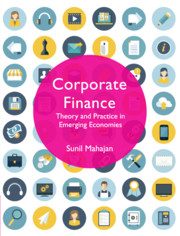Book contents
- Frontmatter
- Contents
- List of Figures
- List of Tables
- List of Corporate Snippets
- List of Abbreviations
- Preface
- Acknowledgements
- 1 Corporate Finance: A Conceptual Introduction
- 2 Financial Markets
- 3 The Time Value of Money
- 4 Capital Budgeting
- 5 Risk and Return
- 6 Valuation
- 7 Capital Structure and Financing
- 8 Dividend Payout: Policy and Practices
- 9 Leverage
- 10 Financial Derivatives
- 11 International Finance
- 12 Working Capital
- 13 Ratio Analysis
- Appendix
- Bibliography
- Index
Appendix
Published online by Cambridge University Press: 30 April 2020
- Frontmatter
- Contents
- List of Figures
- List of Tables
- List of Corporate Snippets
- List of Abbreviations
- Preface
- Acknowledgements
- 1 Corporate Finance: A Conceptual Introduction
- 2 Financial Markets
- 3 The Time Value of Money
- 4 Capital Budgeting
- 5 Risk and Return
- 6 Valuation
- 7 Capital Structure and Financing
- 8 Dividend Payout: Policy and Practices
- 9 Leverage
- 10 Financial Derivatives
- 11 International Finance
- 12 Working Capital
- 13 Ratio Analysis
- Appendix
- Bibliography
- Index
Summary
Efficient Market Hypothesis
Efficient markets hypothesis (EMH) is the foundation of the entire edifice of corporate finance theory. The conceptual framework of corporate finance is premised on the existence of a vibrant, efficient financial market. EMH has two attributes.
1. Prices fully reflect all available information that is relevant to the valuation of securities.
2. Future price movements are random.
Investors in the financial markets trade securities on the basis of their assessment of the worth of those securities. They continuously evaluate securities and compare their value with the price in the market. Value is estimated on the basis of information about the security with respect to the economy, the industry, the company and various other parameters. An efficient market is one where the price of a security is derived on the basis of all the information that is relevant and publicly available.
Since the current price incorporates all the information that is known and available, a change in price can take place only with new information becoming available. By definition, new information is random in nature. Hence, the future price movement is also random. The implications of the EMH are fairly simple but significant. Since future prices are random in nature, they cannot be predicted. By definition, securities are efficiently priced and are unlikely to give extra-normal returns. The fierce competition amongst the large number of extremely savvy and knowledgeable investors ensures that it is difficult to beat the market on a consistent basis, especially after risk is accounted for.
The EMH does not imply that the returns from all investments are equal but that the returns are determined by the risk of the security. Higher the risk, higher is the return and vice versa. An investor can get a higher return if he so desires. However, for that he would need to assume a higher risk of investment. Similarly, the investor may have an appetite for safe investments and less risk which in turn would be associated with lower returns.
Thus there is no free lunch in the financial markets. This is aptly illustrated by the apocryphal story of a finance professor and his student walking down the street when they come across a ₹2,000 note lying on the sidewalk.
- Type
- Chapter
- Information
- Corporate FinanceTheory and Practice in Emerging Economies, pp. 316 - 323Publisher: Cambridge University PressPrint publication year: 2020



